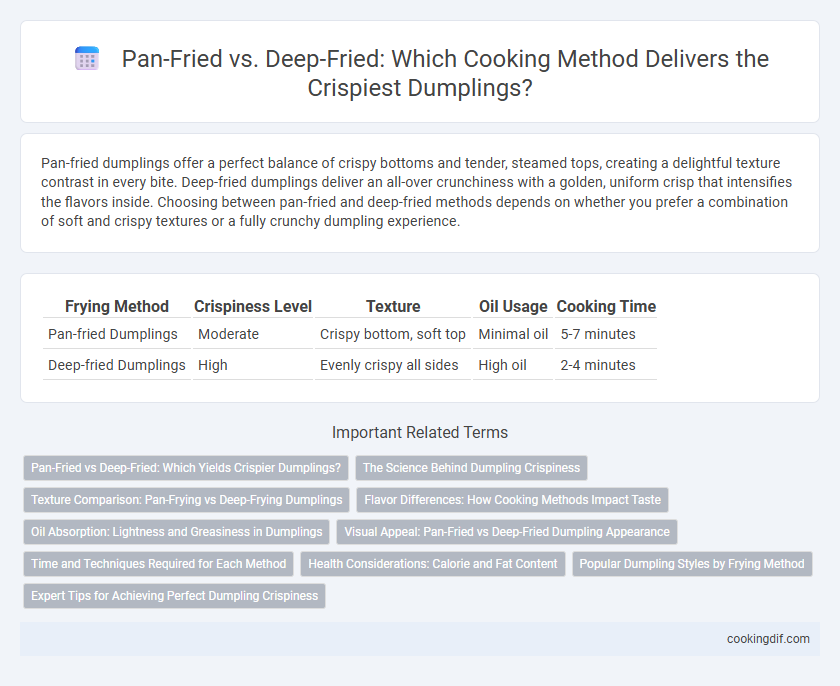Pan-fried dumplings offer a perfect balance of crispy bottoms and tender, steamed tops, creating a delightful texture contrast in every bite. Deep-fried dumplings deliver an all-over crunchiness with a golden, uniform crisp that intensifies the flavors inside. Choosing between pan-fried and deep-fried methods depends on whether you prefer a combination of soft and crispy textures or a fully crunchy dumpling experience.
Table of Comparison
| Frying Method | Crispiness Level | Texture | Oil Usage | Cooking Time |
|---|---|---|---|---|
| Pan-fried Dumplings | Moderate | Crispy bottom, soft top | Minimal oil | 5-7 minutes |
| Deep-fried Dumplings | High | Evenly crispy all sides | High oil | 2-4 minutes |
Pan-Fried vs Deep-Fried: Which Yields Crispier Dumplings?
Pan-fried dumplings develop a golden, slightly crispy bottom with a tender, steamed top, balancing texture and flavor, while deep-fried dumplings achieve an overall crunchier exterior due to full oil immersion. The Maillard reaction in pan-frying creates a distinct crispness localized to the base, whereas deep-frying offers uniform crispiness by rapidly cooking the dough's surface at high temperatures. For maximum crunch, deep-fried dumplings outperform pan-fried versions, but pan-frying provides a combination of crisp and soft textures often preferred in traditional recipes.
The Science Behind Dumpling Crispiness
Pan-frying dumplings creates a Maillard reaction on the surface, producing a golden-brown crust with a perfect balance of crispiness and tenderness by using moderate heat and minimal oil. Deep-frying exposes dumplings to high temperatures and submerges them completely in oil, causing rapid moisture evaporation and forming a uniformly crunchy exterior with a distinct texture. The crispiness in both methods is determined by the interaction of heat, oil, and moisture content, affecting starch gelatinization and the caramelization of the wrapper.
Texture Comparison: Pan-Frying vs Deep-Frying Dumplings
Pan-fried dumplings offer a crispy bottom with a tender, steamed top, creating a balanced texture contrast between crunchy and soft layers. Deep-fried dumplings provide an overall uniform crispiness with a golden, crunchy exterior and a hot, tender interior. The choice depends on whether a combination of crisp and soft textures or a fully crispy experience is preferred.
Flavor Differences: How Cooking Methods Impact Taste
Pan-fried dumplings develop a golden, crispy bottom with a tender, steamed top, creating a contrast that highlights a savory, slightly caramelized flavor. Deep-fried dumplings offer an evenly crispy exterior with a richer, more intense taste due to the oil infusion throughout the dough. The cooking method significantly influences texture and flavor profiles, with pan-frying emphasizing a balanced, nuanced taste and deep-frying delivering a bold, crunchy experience.
Oil Absorption: Lightness and Greasiness in Dumplings
Pan-fried dumplings absorb significantly less oil compared to deep-fried varieties, resulting in a lighter texture with a delicate crispiness that enhances the filling's flavor without overwhelming greasiness. Deep-fried dumplings soak up more oil, producing a thicker, crunchier exterior that can feel heavier and greasy on the palate. Choosing pan-frying optimizes the balance between crispiness and oil absorption for a satisfying yet light dumpling experience.
Visual Appeal: Pan-Fried vs Deep-Fried Dumpling Appearance
Pan-fried dumplings exhibit a golden-brown, slightly uneven crust with a visually appealing contrast between crispy bottoms and tender, steamed tops. Deep-fried dumplings display a uniformly golden, bubbly exterior that is consistently crispy on all sides, enhancing their crunchy texture. The distinct visual cues of pan-fried versus deep-fried dumplings help diners anticipate differences in texture and taste before the first bite.
Time and Techniques Required for Each Method
Pan-frying dumplings requires short cooking time, typically 5 to 7 minutes, combining steaming and frying techniques to achieve a crispy bottom and tender top. Deep-frying demands longer cooking time, usually 3 to 5 minutes in hot oil at 350degF, producing uniformly crispy and golden exteriors with less moisture inside. Mastery of temperature control and timing is crucial in both methods to maintain ideal texture and prevent sogginess or burning.
Health Considerations: Calorie and Fat Content
Pan-fried dumplings contain fewer calories and less fat compared to deep-fried ones, making them a healthier choice for those monitoring their fat intake. The shallow frying method uses less oil, reducing overall calorie consumption while still achieving a crispy texture. Deep-fried dumplings absorb more oil, significantly increasing both calorie count and unhealthy fat content, which can impact cardiovascular health if consumed frequently.
Popular Dumpling Styles by Frying Method
Pan-fried dumplings, such as Chinese potstickers, achieve a delicate crispiness with a golden-brown bottom and a tender top, offering a balanced texture that complements various fillings. Deep-fried dumplings, popular in cuisines like Japanese tempura or Filipino kikiam, deliver an evenly crispy and crunchy exterior due to full immersion in hot oil, intensifying flavor and texture. Both frying methods highlight specific regional tastes and textures, with pan-frying preserving moisture inside and deep-frying creating a bold, consistent crunch.
Expert Tips for Achieving Perfect Dumpling Crispiness
Achieving perfect dumpling crispiness depends on the cooking method: pan-fried dumplings develop a golden, crunchy bottom by using a combination of oil and steam, with expert chefs recommending medium heat and a tight-fitting lid to trap steam while preventing sogginess. Deep-fried dumplings offer an evenly crispy exterior by fully submerging them in hot oil, with the ideal temperature of 350degF (175degC) ensuring a quick, uniform fry that locks in moisture without greasiness. For best results, experts suggest drying dumplings thoroughly before cooking and using a neutral oil with a high smoke point like vegetable or peanut oil to maximize crispiness.
Pan-fried vs deep-fried for dumpling crispiness Infographic

 cookingdif.com
cookingdif.com